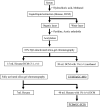Age-related accumulation of persistent organic chemicals in captive king penguins (Aptenodytes patagonicus)
- PMID: 36198610
- PMCID: PMC9705817
- DOI: 10.1292/jvms.22-0245
Age-related accumulation of persistent organic chemicals in captive king penguins (Aptenodytes patagonicus)
Abstract
Persistent organic chemicals are non-biodegradable in nature and have a tendency to bioaccumulate in the top organisms of the food chain. We measured persistent organic chemicals, including polychlorinated biphenyls (PCBs), dichlorodiphenyldichloroethylene (DDE), and benzotriazole-based ultraviolet stabilizers (UV-BTs), in the serum of captive king penguins (Aptenodytes patagonicus) using gas chromatography with an electron capture detector and mass spectrometry to examine their age-related accumulation. PCBs, DDE, UV-PS, and UV-9 were detected in the blood of captive king penguins, and the concentrations of total PCBs, DDE, and UV-9 were positively correlated with age. These results suggest that there is a similar age-related accumulation of persistent organic chemicals in marine birds in the wild, and that older individuals are at a higher risk of contamination.
Keywords: benzotriazole-based ultraviolet stabilizers; blood; dichlorodiphenyldichloroethylene; marine bird; polychlorinated biphenyls.
Conflict of interest statement
The authors declare no conflict of interests.
Figures


Similar articles
-
Accumulation of persistent organic pollutants and benzotriazole UV stabilizers in the preen gland oil of Tristram's storm-petrel (Hydrobates tristrami).Mar Pollut Bull. 2025 Sep;218:118213. doi: 10.1016/j.marpolbul.2025.118213. Epub 2025 May 30. Mar Pollut Bull. 2025. PMID: 40449468
-
Polybrominated diphenyl ethers, polychlorinated dibenzo-dioxins, -furans, and -biphenyls in three species of Antarctic penguins.Environ Sci Pollut Res Int. 2007 Sep;14(6):421-9. doi: 10.1065/espr2006.01.017. Environ Sci Pollut Res Int. 2007. PMID: 17993226
-
Interspecific and intraspecific variation in organochlorine pesticides and polychlorinated biphenyls using non-destructive samples from Pygoscelis penguins.Environ Pollut. 2021 Apr 15;275:116590. doi: 10.1016/j.envpol.2021.116590. Epub 2021 Feb 1. Environ Pollut. 2021. PMID: 33582630
-
Trace organic compounds in the marine environment.Mar Pollut Bull. 2002;45(1-12):62-8. doi: 10.1016/s0025-326x(02)00104-2. Mar Pollut Bull. 2002. PMID: 12398368 Review.
-
Developmental neurotoxicity of persistent organic pollutants: an update on childhood outcome.Arch Toxicol. 2015 May;89(5):687-709. doi: 10.1007/s00204-015-1463-3. Epub 2015 Jan 25. Arch Toxicol. 2015. PMID: 25618547 Review.
Cited by
-
PCBs in Chinstrap Penguins from Deception Island (South Shetland Islands, Antarctica).Toxics. 2025 May 24;13(6):430. doi: 10.3390/toxics13060430. Toxics. 2025. PMID: 40559904 Free PMC article.
-
Effects of Pharmaceuticals and Endocrine-Disrupting Chemicals on Reproductive Biology of Aquatic Fauna: Penguins as Sentinel Species.J Xenobiot. 2025 Jul 4;15(4):110. doi: 10.3390/jox15040110. J Xenobiot. 2025. PMID: 40700157 Free PMC article. Review.
References
-
- Angelier F, Weimerskirch H, Dano S, Chastel O. 2007. Age, experience and reproductive performance in a long-lived bird: a hormonal perspective. Behav Ecol Sociobiol 61: 611–621. doi: 10.1007/s00265-006-0290-1 - DOI
-
- Barron MG, Galbraith H, Beltman D. 1995. Comparative reproductive and developmental toxicology of PCBs in birds. Comp Biochem Physiol C Pharmacol Toxicol Endocrinol 112: 1–14. doi: 10.1016/0742-8413(95)00074-7 - DOI
-
- ChemSrc. 2021. A Smart Chem-Search Engine. https://www.chemsrc.com/en/ [accessed on July 8, 2022].

